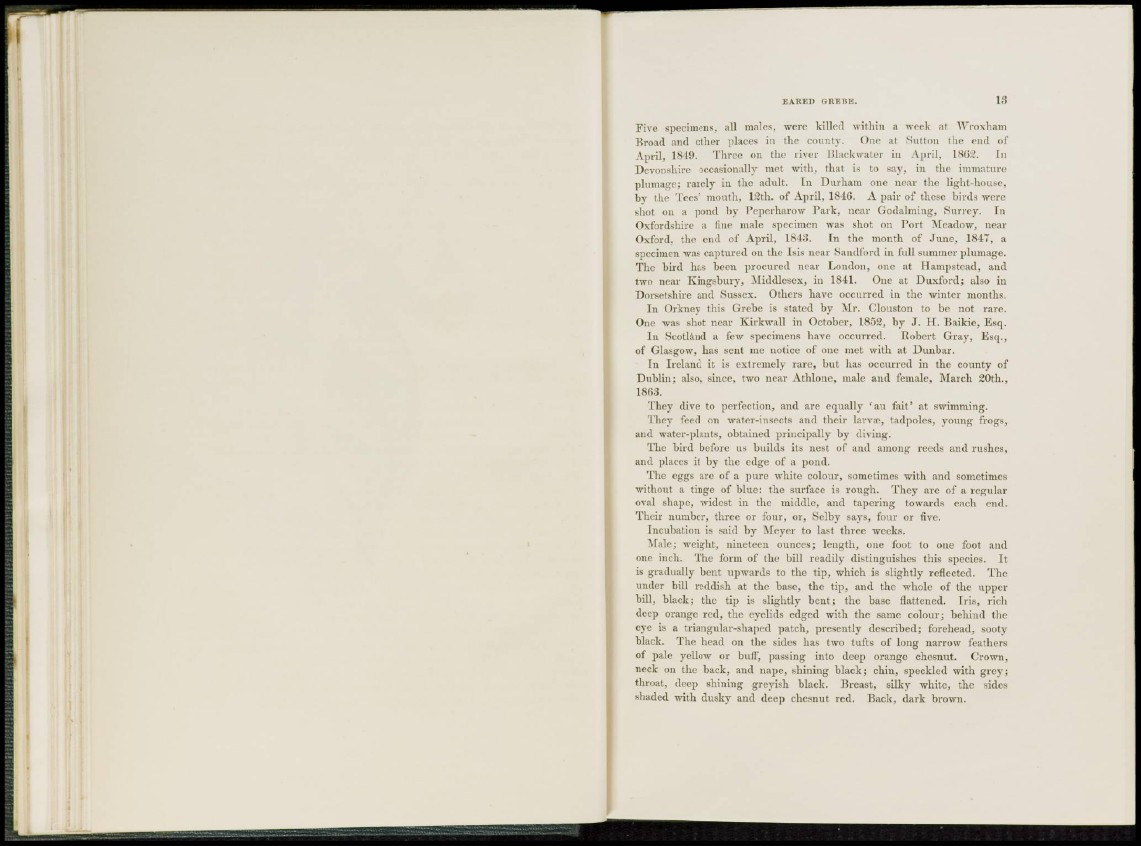
F i v e specimens, all males, were lulled within a week at Wroxham
Broad and other places in the county. One at Sutton the end of
A p r i l , 1819. Three on the river Blackwater in April, 1862. In
Devonshire occasionally met with, that is to say, in the immature
plumage; r a r e l y in the adult. In D u r h a m one near the light-house,
by the Tees' mouth, 12th. of A p r i l , 1846. A pair of these birds were
shot on a pond by P e p e r h a r ow Park, near Godalming, Surrey. In
Oxfordshire a fine male specimen was shot on Port Meadow, near
Oxford, the end of April, 1843. In the month of J u n e , 1847, a
specimen was c a p t u r e d on the Isis near Sandford in full summer plumage.
The bird has been procured near London, one at Hampstcad, and
two near K i n g s b u r y , Middlesex, in 1841. One at D u x f o r d ; also in
Dorsetshire and Sussex. Others have o c c u r r e d in the winter months.
I n Orkney this Grebe is stated by Mr. Clonston to be not rare.
One was shot near K i r k w a l l in October, 1852, by J. H . B a i k i e , Esq.
I n Scotland a few specimens have occurred. Robert Gray, Esq.,
of Glasgow, has sent me notice of one met with at Dunbar.
I n Ireland it is extremely r a r e , b u t has o c c u r r e d in the county of
D u b l i n ; also, since, two near A t h l o n e , male a n d female, March 20th.,
1863.
They dive to perfection, and are equally ( a u fait' at swimming.
They feed on water-insects and their larva1 , tadpoles, young frogs,
and water-plants, obtained p r i n c i p a l l y by diving.
The bird before us builds its nest of and among reeds and rushes,
and places it b y the edge of a pond.
The eggs are of a p u r e white colour, sometimes with and sometimes
without a tinge of b l u e : the surface is rough. They are of a r e g u l ar
oval shape, widest in the middle, and tapering towards each end.
Their number, three or four, or, Selby says, four or five.
Incubation is said b y Meyer to last t h r e e weeks.
Male; weight, nineteen ounces; l e n g t h , one foot to one foot and
one inch. The form of the bill r e a d i l y distinguishes this species. It
is gradually bent u p w a r d s to the t i p , which is slightly reflected. The
under bill reddish at the base, the t i p , and the whole of the upper
bill, black; the tip is slightly b e n t ; the base flattened. Iris, rich
deep orange red, the eyelids edged with the same colour; behind the
eye is a t r i a n g u l a r - s h a p e d patch, p r e s e n t l y described; forehead, sooty
black. The head on the sides has two tufts of long n a r r ow feathers
of pale yellow or buff, passing into deep orange chesnut. Crown,
neck on the back, and nape, s h i n i n g b l a c k ; chin, speckled with g r e y;
throat, deep shining greyish black. Breast, silky white, the sides
shaded with dusky and deep chesnut red. Back, d a r k brown.